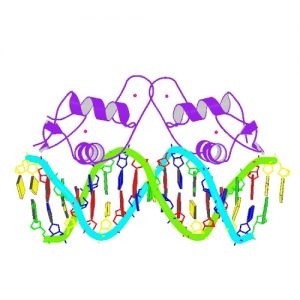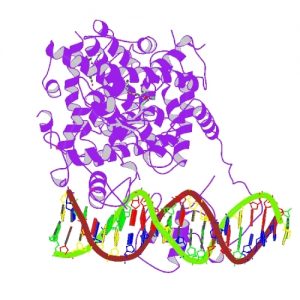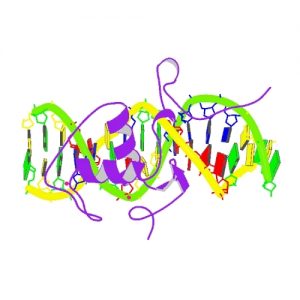Nuclear receptors recognize specific sequences in DNA as if they were words. These sequences follow this general consensus (with some variability):
RGGTCA
R indicates a purine (that is, A or G)
Remember, DNA is made up of a double strand, and nucleotides recognize each other. Hence, strictly speaking, the word would be:
RGGTCA
YCCAGT
Y indicates a pyrimidine (that is, T or C)
[clear]
Paired
Most of the time, these words are not isolated but written in pairs and separated by a variable number of other nucleotides (which are represented by an X, the universal unknown). This is how “hormone phrases” or, strictly speaking, hormone response elements (HRE) are formed.
RGGTCAxxxRGGTCA
YCCAGTxxxYCCAGT
Reversed
Moreover, words can also be recognized even if they are reversed. Thus, we can find two words written in the same order (as in the previous example) or reversed:
RGGTCAxxxTGACCY
YCCAGTxxxACTGGR
It follows that the sequence of hormone response elements determines which receptors recognize them and whether they bind individually or in pairs (which occurs most of the time).
Nuclear Literacy
Each nuclear receptor recognizes specific elements. This high level of specificity is attained by means of differences:
- In the sequence of words (what letters make them up?)
- In the distance between the words (how many nucleotides are between them?)
- In the order of the words that are repeated (are they in the same order or reversed?)
Let’s take a look at some examples of this specificity.
Steroid hormone receptors recognize repeated words that are inverted (IR, from inverted repeats) and separated by three nucleotides. That is, IR3 elements. At a sequence level, GR recognizes AGAACA, while ER recognizes AGGTCA.

Receptors that partner with the nuclear receptor RXR recognize the word AGGTCA repeated in the same order. This is known as direct repeat (DR). These words can be separated by 1 to 5 nucleotides (from DR1 to DR5). And, in this case, this separation determines which receptor (in partnership with the RXR) will recognize this element.

Some receptors (such as monomers) bind to DNA by themselves. This is the case of NGFI-B or ROR.

Images: Protein Data Bank
[one_half first]
[icon style=”default” size=”20″]fa-chevron-left[/icon] Taking Apart a Receptor
[/one_half]
[one_half]
It Helps to Have Ligands in High Places [icon style=”default” size=”20″]fa-chevron-right[/icon]
[/one_half]

